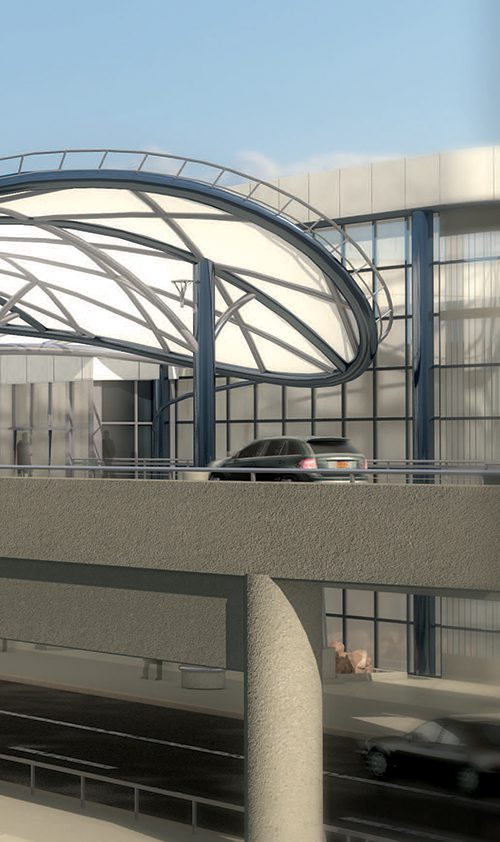New York Governor Andrew M. Cuomo has put the state’s money where its airports are. Recognizing and emphasizing the importance of air transportation to general economic prosperity, the governor launched the $200 million Upstate Airport Economic Development and Revitalization Competition in 2016.
The state allocated up to $190 million for the competition and another $10 million through the Governor’s Aviation Capital Grant Program to support safety, infrastructure and economic development projects at airports across the Empire State. This $200 million in new funding is in addition to $90 million authorized for core airport improvement projects statewide as part of the governor’s $29 billion five-year State Transportation Plan.
Upstate general aviation and commercial service airports were invited to apply, and successful airports could receive up to $40 million each. A total of 16 airports applied, and to date, four received awards totaling $153.6 million. (See list for winning airports and their individual awards.) Remaining funds will be allocated in the near future.
|
facts&figures Project: Airport Development Funding Location: New York State Program: Upstate Airport Economic Development & Revitalization Competition Total Maximum Award: $200 million (up to $40 million/winner) Proposal Evaluator: New York State Dept. of Transportation Scheduling/Cost Monitoring Services: WSP
Timeline: Awards granted in 2016/2017; projects Program Objective: Facilitate community & regional economic development via financial support for airport improvements
Award Winners Airport: Elmira Corning Regional Project: Terminal Expansion & Renovation Projected Total Cost: $58 million Competition Award: $40 million Additional Funding: Current & future entitlement & discretionary Airport Improvement Program grants; local & state funds
Airport: Greater Rochester Int’l Project: Terminal Renovations Projected Total Cost: $79 million Competition Award: $39.8 million
Additional Funding: Passenger facility charge
Airport: Plattsburgh Int’l
Project: Cargo, General Aviation Projected Total Cost: $42 million Competition Award: $38 million Additional Funding: Public/private
Airport: Syracuse Hancock Int’l Project: Terminal Renovations Projected Total Cost: $62.4 million Competition Award: $35.8 million
Additional Funding: Airport authority; county; |
Applicants were required to provide detailed project budgets as well as plans, drawings, reports and other supporting documents. Applications were evaluated on design innovation, passenger amenities and customer experience enhancements, cargo facility expansion, long-term job creation and generation of economic opportunities at and around the airport. Eligible projects included retail, hotel and conference center development; enhanced highway and transit access; improved security and screening methods; terminal expansion and rehabilitation; runway extension and rehabilitation; boarding, concourse and concession area enhancements; and aviation-related technology improvements.
When announcing the competition, Governor Cuomo highlighted the importance of investing in airport infrastructure and its role in the state’s future economic prosperity. “Through this competition, we are transforming these upstate airports into 21st century transportation hubs to ensure they generate economic opportunity for local economies for generations to come.”
And the Winners Are…
To date, the following airports have been selected to receive funding:
• Elmira Corning Regional (ELM)
• Greater Rochester International (ROC)
• Plattsburgh International (PBG)
• Syracuse Hancock International (SYR)
Awards were based on publicly available scoring criteria, and economic development was the “guiding light” in the selection process, says Paul Karas, acting commissioner for the New York State Department of Transportation. “Broadly speaking, tourism has a multibillion dollar impact throughout New York State—$100 billion last year—and these airports are located near huge tourist attractions,” he explains. “We also need to provide top-notch transportation resources for people working at our universities, research institutes and support the state’s industrial and agricultural activities.”
To illustrate another aspect, Karas cites the recent decision of the New York Mets’ triple-A farm team to relocate from Las Vegas to Syracuse, NY. “One of the main reasons for the move was the attractiveness of the Syracuse Airport facilities,” he states.
With a substantial completion deadline of Oct. 31, 2018, for their projects, the four airports selected to receive awards had little time to celebrate their good fortune. “The whole process has been a whirlwind,” remarks Christopher Kreig, airport director at PBG. “We found out we were a recipient in January 2017 and have been very busy ever since.”
Bill Hopper, director of aviation at ELM, concurs: “The timeframe we have to complete a project of this scope would, in more normal circumstances, be the amount of time we’d spend on design alone. We’re pretty much designing on the fly. We built about 30% contingency into our budget because we knew there would be unanticipated costs.”
Greater Rochester Int’l
ROC, the first winner announced, received $39.8 million for its $79 million project. “By transforming the Rochester Airport, we create a world-class hub to drive economic activity and growth throughout the region,” said Governor Cuomo in September 2016.
According to a 2010 Department of Transportation Aviation Report, ROC generates more than $800 million in economic impact for the region each year and supports approximately 10,000 full- and part-time jobs.
“The airport serves as the gateway to Rochester and the Finger Lakes Region,” notes Interim Aviation Director Andy Moore. “This revitalization project enhances the overall experience for the 2.4 million passengers traveling through the airport each year.”
The winning project will encompass:
• terminal renovations, including the addition of enhanced shopping and dining options;
• a smart energy management system to control heating/venting/air conditioning and lighting in all areas of the building;
• a new 85,000-square-foot terminal entrance canopy to provide shelter and allow for installation of additional security cameras;
• changes at the TSA checkpoint to minimize wait times;
• a 32-space Smart Phone Lot, complete with free Wi-Fi, charging stations for electric cars and a flight information display;
• color-coded signage and navigation cues between concourses A and B, and digital information visible to guide passengers heading to either concourse;
• new energy-efficient windows in the expanded food court area;
• Wi-Fi connectivity to a new passenger information system accessible on mobile devices for passenger wayfinding, flight status and gate information;
• hundreds of new charging stations for passengers’ electronic devices;
• interactive play areas for passengers of all ages, through a collaboration with The Strong National Museum of Play:
• new approach roadway signage, landscaping and improved LED roadway lighting; and
• state-of-the-art technology to make travel easier for deaf and hearing-impaired visitors.
The Greater Rochester area has one of the nation’s highest per capita populations of residents who are deaf or hard of hearing, informs Moore. The National Technical Institute for the Deaf, the world’s largest college for students who are deaf and hard of hearing, is located in Rochester.
The airport has taken a proactive approach to assist this population by installing hearing loops, an FM system that helps visitors receive messages from the public address system via T-coil devices in their ears. ROC is also working with the Rochester Institute of Technology to install screen devices at ticket counters and other key transaction points that translate American Sign Language into voice or printed content.
“Our original cost estimate when we applied for the award was $54 million,” Moore reports. “But once we got into the design and engineering, and then decided to take this opportunity to expand the project, we came up with the more realistic number of $79 million. We are very appreciative of Governor Cuomo’s initiative and fortunate to have tremendous leadership from Monroe County Executive Cheryl Dinolfo, who values investing in our airport as an economic driver in our community.”
Elmira Corning Regional
ELM was also announced as an award-winner in September 2016. It received the maximum $40 million toward a $58 million project that includes:
• increasing terminal space by 25%;
• raising the concourse, adding one new jet bridge and refurbishing two existing bridges;
• adding space for a second baggage claim;
• adding 300 new parking spaces;
• constructing café and retail kiosks post-security and a 3,000-square-foot restaurant and bar pre-security;
• adding enclosed courtyards to showcase the local landscape and enhance passengers’ travel experience; and
• installing programmable glass walls that display flight information and wayfinding information.
Previously, the airport had no airside food and beverage options, Hopper informs. Initial plans called for adding a 3,000-square-foot concession post-security, but airport authorities ultimately placed the new food and beverage option before the TSA checkpoint, because ELM’s post-security area is only open for a few hours in the morning and afternoon.
 “We settled on kiosks post-security, with the main vending areas pre-security, since a major vendor post-security would not be able to sell product when the area was closed,” Hopper explains.
“We settled on kiosks post-security, with the main vending areas pre-security, since a major vendor post-security would not be able to sell product when the area was closed,” Hopper explains.
Airport officials are particularly pleased with plans for the three new courtyards. One is inaccessible to the public but visible from the baggage and security screening areas; another can be accessed from the landside restaurant; and the third is a post-security space passengers can enjoy while waiting for their aircraft to arrive.
“Travelers moving through TSA screening actually wind between two courtyards,” explains Hopper. “We call it a walk through the woods.”
He notes that the program’s tight deadlines have made the design and construction process challenging, but all the stakeholders see the value of the projects.
“We are getting a renovated terminal building for little local share cost, which translates into minimal costs for the airlines,” Hopper emphasizes. “We’re making it work. Come August of this year, we’ll have a brand new boarding area; and come next October, a whole new building.”
 Plattsburgh Int’l
Plattsburgh Int’l
PBG was just putting the finishing touches on a $60 million terminal expansion when the upstate project competition was announced. Inspired by the chance to win funding for future improvements, they pushed through the natural post-project fatigue and began thinking about other items on their to-do list.
Although they had multiple ideas to enhance the passenger travel experience (civil site work, parking lot pavement repairs, further improvements inside the terminal), officials focused on cargo and general aviation projects for the airport’s application. They also keyed in on the business-to-business development described in the competition guidelines.
The strategy proved to be a winning approach, as PBG was awarded $38 million toward its $42 million project proposal. Specific components include:
• adding new retail and concession options, including a new dining facility;
 • renovating two industrial buildings (90,000 square feet total) for light manufacturing activity;
• renovating two industrial buildings (90,000 square feet total) for light manufacturing activity;
• constructing a new 60,000-square-foot light industrial manufacturing facility;
• building a 10,000-square-foot distribution center for tenants in the airport’s industrial complex;
• adding a new general aviation Customs facility;
• demolishing several buildings that are beyond their useful lifespans;
• adding a connecting corridor for passengers arriving on international flights;
 • constructing a Clinton County Transit Center;
• constructing a Clinton County Transit Center;
• adding charging stations for electric vehicles;
• preparatory work for hotel development; and
• renovating the car rental building to speed vehicle turnaround.
“All told, we have over 200 acres of developable space,” Kreig informs. “Our chamber of commerce has done a great job fostering relationships with our cross-border friends. This project will help us attract Canadian businesses to the area. From building renovations to new construction, we are in a position to address the needs of companies looking for usable space.”
 Syracuse Hancock Int’l
Syracuse Hancock Int’l
SYR received $35.8 million to update its aging infrastructure. The airport’s $62.4 million project will include:
• redesigning the terminal building to create a more spacious and light-filled central hall;
• constructing a regional aviation museum, with assistance from the Onondaga Historical Association;
• adding a new exterior glass wall facade, with a green roof curb-front canopy;
• renovating two pedestrian bridges, so travelers with mobile app boarding passes can connect directly from the parking garage to the terminal’s second floor security checkpoint;
• adding weather-resistant architectural steel exterior panels, energy-efficient windows and a rainwater collection system; and
• installing new terrazzo flooring and energy-efficient lighting.
The various projects support the airport’s goal of creating a seamless passenger experience—which begins when travelers are dropped off at the curb or park in the garage, notes Airport Director Christina Callahan. Rather than encountering a solid wall, travelers will be greeted with a translucent glass wall with a sightline through the terminal to a matching glass curtain wall on the other side of the TSA checkpoint. Overhead, a translucent glass canopy filters natural light onto the terminal roadway and sidewalk.
Inside, travelers are welcomed into a bright, open space. The grand staircase and stone wall in the central lobby provide easy places for passengers to rendezvous with colleagues or loved ones. “From an architectural design perspective, we’ve deliberately constructed and highlighted features that can serve as reference points for travelers,” explains Callahan.
In reflecting on what the award means for the airport and community, Callahan says that the state funding has helped the airport authority create a world-class facility much sooner than would have been possible otherwise. Moreover, the award allows authority funds to be directed toward additional important projects and priorities.
As acting transportation commissioner, Karas acknowledges that small and medium-size airports often have to scramble for project funding. “When these airports get 5% to 10% state funding with perhaps a local match, that’s a good day,” he reflects. “New York state has stepped up to the plate to provide a large chunk of funding for major airport projects. That’s huge, and the reaction of the award winners has been great delight. By helping airports, we are helping the economy.”



